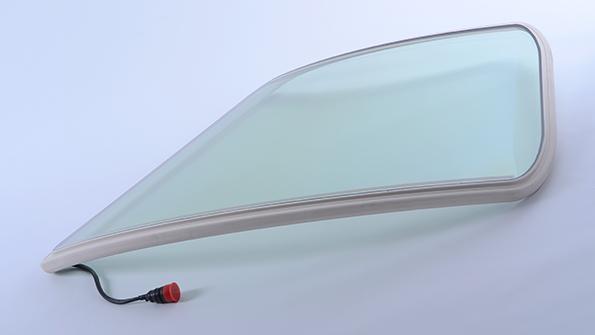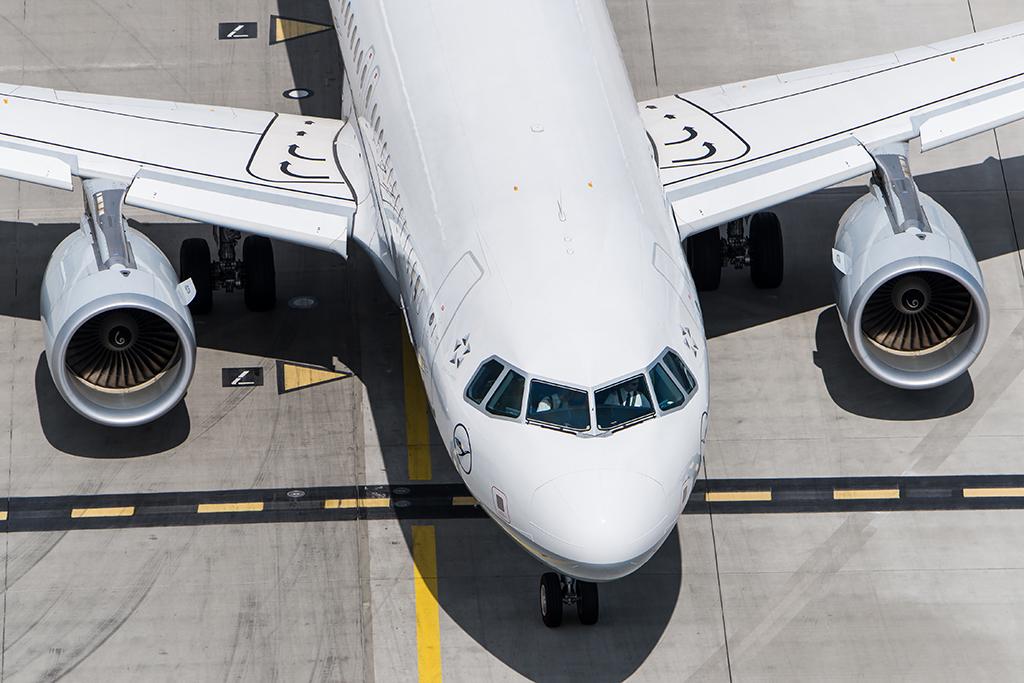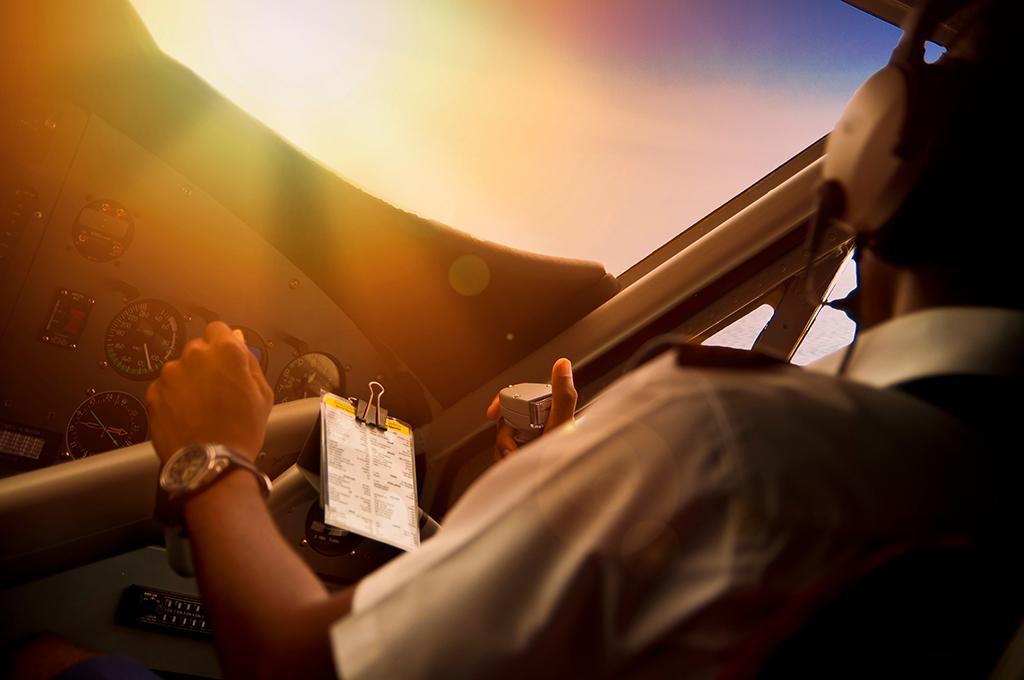Windscreen OEMs Push Performance, Durability, Sustainability Advances

Saint-Gobain windscreens, designed around the proprietary Solidion glass material, can provide a hydrophobic function, eliminating the need for wipers.
Cockpit windscreens are incorporating new design engineering developments as customers demand greater capabilities and lower ownership costs.
The demand for tighter tolerances, increased aerodynamic performance and lighter weight have been the driving requirements for cockpit windscreens in the past several years, according to Jason Webb, program development director at GKN Aerospace’s transparencies site in Garden Grove, California. “Increased meantime between failure is also key for aircraft operators.”
To achieve those requirements, Webb says the OEM is continuing to improve its manufacturing methods and processes to reduce essential failure modes, such as delamination, electrical failure and premature ply breakage. “External coatings are continually being developed to provide greater and permanent hydrophobicity and abrasion resistance to provide longer-lasting high optical clarity,” he notes.
For example, Webb points out that GKN Aerospace is introducing a permanent hydrophobic and abrasion-resistant glass coating that is in the final development stage, which includes flight testing. “Current hydrophobic coatings do not last long and have to be reapplied by operators,” he says. “A permanent coating would remove that maintenance task and would provide another maintenance benefit in the form of greater abrasion resistance, which will reduce windscreen wiper damage.”

GKN Aerospace has also extended the life of its windscreens through the application of ultraviolet (UV) ray blockers as part of the raw material mix. For instance, GKN Aerospace applies its Acrivue acrylic to all its acrylic windows. “GKN Aerospace has incorporated external and internal coatings and interlayers that reduce UV light transmission on various designs,” Webb says.
Asked whether windscreens are trending away from incorporating glass and toward greater use of high-performance plastics and acrylics, Webb says that will depend on unique flight profiles, customer requirements, airframe curvature and damage resistance.
“Generally, we are still seeing the No. 1 panel—the center windscreen panel—consisting of glass or a glass face acrylic, which is made up of a glass outer ply, and acrylic structural plies,” he notes. “The glass face acrylic is a very complicated design to get right. That is why the No. 2 and No. 3 windshields—which extend to either side of the center panel—may go to acrylic.”
Highly curved windscreens, Webb adds, are even more difficult to fabricate in glass, possibly driving their design toward acrylic. “We are seeing more of them on commercial and business aircraft because they can be tailored to the particular aircraft and aerodynamic requirements, including inflight deflections,” he says. “At the same time, they have challenges with optics—particularly distortion—that must be overcome.”
Contoured windscreens also come with a weight penalty, according to Brent Wright, global director of aerospace transparencies at aviation coatings supplier PPG. “Transport aircraft fuselage designs have evolved to incorporate more contoured aircraft windshields,” he notes. “Contoured flight deck windows offer obvious aerodynamic efficiency as well as not-so-obvious weight savings enabled by inherent strength gains with contoured windows.”
Teddy Gil, chief administrative officer at aerospace engineering services company Sheffield Aerospace, is more cautious on the subject of windscreen curvature design technology. “There would be an advantage if the curvature could improve aerodynamic flows,” he says. “However, the disadvantage would be the increased expense due to additional molding requirements and processes to achieve the desired curves.”
Webb stresses that weight is always a factor with new designs. During design and development testing, the thickness of glass and acrylic windscreen products is highly optimized for the lowest weight possible while still meeting the performance requirements.
Along this line, Webb says GKN Aerospace has developed a proprietary software to analyze aerodynamic deflection and bird-strike impact to narrow down the optimized design early in the process. “Onsite bird-strike testing is still required to ensure that the final thicknesses provide a safe windshield for operators,” he says.
Asked about GKN Aerospace’s sustainability measures regarding windscreens, Webb replies that, as with many products, the company has several approaches. Among them are reducing scrap and emissions, identifying waste in the process through lean manufacturing, removing or controlling hazardous substances and increasing the reliability and life of the product produced. “We also need to work harder on increasing the repairability of the products to reduce the overall footprint,” he notes.
At Pittsburgh-headquartered PPG, the target areas for windscreen technology investments include lightweight transparencies, durability improvements and flight crew safety enhancements, Wright says. He cites PPG’s most recent innovations, such as the Solaron Blue Protection UV+ and its WinLogic Intelligent Window Systems.
Wright describes Solaron Blue Protection UV+ as a “material innovation” enabling PPG’s cockpit window products to provide elevated crew protection against harmful UVA, UVB and high-energy visible light rays that can cause cancer and eyesight degradation. PPG’s WinLogic Intelligent Window Systems “incorporate innovative electronic circuitry,” he says, that detect windshield heating system anomalies before they devolve into electrical faults.
Advances in materials and design have increased aircraft transparency service lives significantly in the past 20 years, considering the stresses they endure, Wright says.
“Windshields remaining on an aircraft for as many as 10 years—twice as long as the windows produced in the 1990s—are no longer uncommon,” he notes. “The challenge is to tighten the range and improve service life predictability by investing in design and process techniques, such as better moisture protection and advanced heating sensors.”

PPG has also addressed durability through other innovations, including Herculite II, a chemically toughened glass that will bear significant design loads and withstand various environmental threats, such as foreign object damage. In addition, PPG’s Opticor, a new, advanced transparent material, offers abrasion resistance and environmental durability, especially when used for rotorcraft and wingtip lens applications.
“External transparency coatings can be applied for various purposes, such as rain shedding, abrasion, chemical resistance and electrostatic discharge,” Wright says. The OEM’s latest Surface Seal rain-repellent coating incorporates “a more environmentally friendly chemistry.”
Wright adds that PPG has developed conductive coatings that facilitate the dissipation of an electrostatic charge buildup on the exterior of flight deck windows, too. “A sudden discharge of electrostatic potential can damage the a windshield heating system or outer-face ply,” he notes.
Given the new technology materials increasingly used in cockpit windscreens, does glass have a future? Wright says so.
“Glass windscreens are highly durable and offer excellent performance properties,” he says. “While glass is obviously heavier than plastic, it is a stable, well-known material for many transport aircraft applications. Where the application is perhaps highly weight-sensitive, plastic or a combination of materials might be appropriate. PPG has certified civil aircraft transparencies that utilize glass, acrylic, polycarbonate, Opticor advanced transparent material or some combination thereof.”
Along with ongoing innovations, PPG is making its production process more sustainable in terms of chemistry, energy intensity and water usage, aided by increasingly efficient manufacturing equipment. “We have updated the chemistry of various products to make them more environmentally friendly,” Wright says. “For example, we now use nonchromated coatings and sealants, where available.”
Sylvain Mourlhon, commercial director at Saint-Gobain Aerospace, says the company is looking to implement more sustainable products as well, with a path toward carbon neutrality through each step in a product’s life cycle. “Our approach is to offer sustainable services, including a strong repair capability of our transparencies,” he says.
Mourlhon adds that weight has always been a critical driver, especially in sustainable aircraft design. Saint-Gobain is achieving greater sustainability through windscreen designs that use its proprietary Solidion glass materials, he says, and through the integration of the windscreen and aircraft structure. According to Mourlhon, incorporating a hydrophobic function eliminates the need for a wiper system, and adding an anti-fog coating optimizes the need for air conditioning and heating systems. He stresses, however, that aircraft specifications and windshield requirements will drive the design and materials selections to achieve the optimization between mechanical performance, weight and optical clarity.
“These are examples of how we can make smarter windshields that help reduce the need for energy for temperature control while saving the weight of an additional system,” Mourlhon says. “The design itself and especially interface optimization between the fuselage and the windshield are also key weight savings to consider in the global aircraft architecture.”
Yet windscreen designs, he notes, are trending larger with more contours because that helps to satisfy regulatory requirements concerning pilot visibility while providing better aerodynamic performance.
“For example, when you compare the Dassault Falcon 900 cockpit window system, which is made of seven flat windscreens, to the new Falcon 10X, you can see that the Falcon 10X is using four large curved windscreens,” Mourlhon says.




